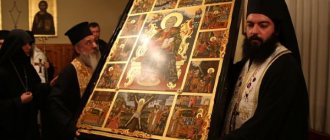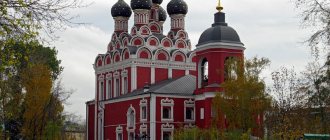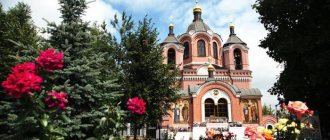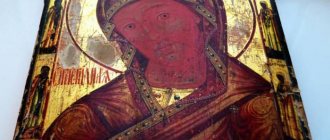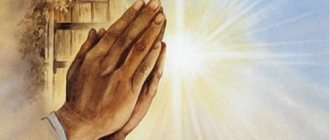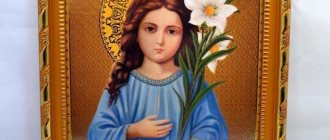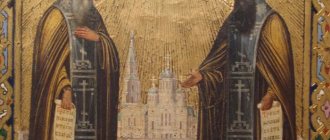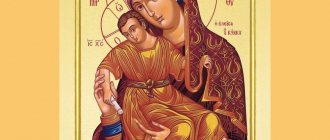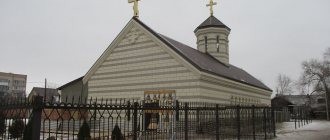People turn to her with prayers for help, requests for healing or intercession. They say thank you for the help provided in difficult life situations. She is considered a symbol of the highest kindness, meekness, chastity and wisdom. She is the Mother of God, whose icons are in every Orthodox church, and all the images are difficult to list and view. It is also present in the homes of people who believe in God and keep his commandments.
Various icon options
The Mother of God is represented in icons in different ways. Each of them has its own name; the meaning of the icon of the Virgin Mary may also differ in some details. It helps resolve a certain life situation that has occurred in the life of someone in need of help. Her appearance is always depicted as a little sad, meek. This is the only way Virgo can look at people, because they live in constant trouble, suffer, and sin.
It would take a huge catalog to list all the icons of the Mother of God with names, because in addition to the originals there are numerous lists, which were often glorified separately. Therefore, first it is better to consider the main types of icons of the Virgin Mary:
- Hodegetria - these icons of the Mother of God are depicted with a baby on her left hand, they can be used with different names, but the Mother of God always points to Christ, and the Infant God makes a blessing gesture, they also happen with a baby on her right hand, the situation with the names is identical here, they are different , but canonical is general;
- Eleusa - They pressed their cheeks to each other, symbolically such icons of the Mother of God indicate the high importance for every person of a reverent attitude towards the Lord;
- Oranta - this type of Mother of God icons includes those where a medallion with Christ is depicted on the chest of the Virgin Mary, and she raises her hands to the sky, praying for people and asking for the mercy of the Lord;
- Akathist - the name of the icons is conditional, it is also possible to call these images plot, here icons of the Mother of God and saints are often combined, the essence is to glorify a certain quality of the Mother of God, which is noted in the akathists.
It is impossible to list how many icons of the Mother of God there are, but there is an opportunity to try, based on the previous classification, let us consider the most famous images:
- Hodegetria - the miraculous icon of Kosinskaya (Modena), the Damascene icon, which is also called the Three-Handed One, the Hearer, the icon with the ladder, Corfu, Gerbovetskaya,
- Eleusa – Yaroslavl icon, Volokolamsk, Balykin, Feodotyevsk, Yelets, Rozhkov,
- Oranta - Novgorod, Alabatskaya, Unbreakable Wall, Inexhaustible Chalice;
- Akathist - Trubchevskaya (although it can also refer to the first type), Augustovskaya, Kiprskaya.
Separately, we should highlight icons of the Mother of God not made by hands, that is, those that were given from above. These images were imprinted on some surface or people simply found an icon somewhere
These rare icons of the Mother of God are revered in a special way and are often miraculous.
Icons of the Mother of God with photos and descriptions
Below is a list of Holy Faces, the most popular or, on the contrary, little known, whose history or description is very interesting.
"Kazan" Icon of the Mother of God
Celebrated on July 21 and November 4. The miraculous image saved the country in times of unrest, disasters and wars. Its significance is to preserve the country under the shadow of the Mother of God.
The most revered image in Rus'. Found in 1579 in Kazan in a fire during the persecution of Christians. They bless married couples, pray for the healing of eye diseases, and to repel foreign invasion.
Body icon with chain “Matrona of Moscow” - a spiritual and beautiful gift for loved ones - buy for 1,490 rubles
Icon of the Mother of God “Inexhaustible Chalice”
Celebrated on May 18th. They pray for deliverance from drunkenness.
In 1878, one retired soldier suffering from heavy drinking had an apparition of St. Varlaam to go to the city of Serpukhov and pray there in front of a certain image. This icon turned out to be the now famous “Inexhaustible Chalice”.
Icon of the Most Holy Theotokos “Theodorovskaya”
Celebrated on March 27 and August 29. They ask her for a happy marriage and healthy children.
Possibly written by the Apostle Luke. It was located in the 12th century in the city of Gorodets. She miraculously moved to Kostroma: she was seen in the hands of St. the warrior Theodore Stratilates, who walked with her through the city. Hence the name “Feodorovskaya”.
"Sovereign" Mother of God
Celebrated on March 15th. The meaning of the image is that power over Russia passed from the Tsar directly to the Virgin Mary.
Revealed in 1917 in the village of Kolomenskoye, in the Moscow region, on the very day on which Nicholas II abdicated the throne. The Most Holy Theotokos seemed to have received the power from the Tsar.
"Vladimir" icon
Celebrated on June 3, July 6, September 8. The significance of the image for Orthodox Christians in preserving Russia from foreign warriors.
Written by the Apostle Luke on the tabletop of the Holy Family. Saved Moscow from the invasion of Tamerlane. Under Soviet rule, she exhibited at the Tretyakov Gallery.
"Tikhvin" Mother of God
Celebrated on July 9th. The meaning of the image is that it protects the northern borders of Russia.
This image, according to legend, was written by the evangelist and apostle Luke. He miraculously appeared near the city of Tikhvin. Particularly remarkable among the many miracles revealed by the image was the salvation of the Tikhvin monastery during the Northern War in 1613.
"Three-handed"
Celebrated on July 11 and 25. Means the omnipotence of God's miracles.
So named after a miracle that happened to St. John of Damascus. His severed hand grew back into place through prayer at the image of the Mother of God. In honor of this event, a silver hand was attached to the frame of the image.
"Unexpected Joy"
Celebrated on May 14 and December 22. The meaning of the image lies in the mercy of the Mother of God even towards unrepentant sinners, leading them to repentance.
The icon is named in memory of the conversion of one lawless man, who, with the Archangel's greeting, asked for a blessing for his lawless deeds.
"Blessed Womb"
Celebrated on May 21st. Provides assistance during childbirth.
In the 14th century it was located in the Annunciation Cathedral of the Kremlin. Glorified by many miracles.
"Annunciation"
Celebrated on April 7th.
The image is dedicated to the twelfth holiday of the same name.
"Blessed Sky"
Celebrated on March 19th. The meaning of the image is that it is in this form that, according to the assumption, the Blessed Virgin Mary will descend to earth, preparing people for the second coming of Christ.
The image was brought to Moscow by the Lithuanian princess Sofia Vitovtovna at the beginning of the 15th century.
"Joy of All Who Sorrow"
Celebrated on November 6th. The icon means the mercy of the Mother of God to the offended and suffering.
In 1688, the sick Euphemia, a relative of the patriarch, suffering from an incurable disease, was miraculously healed in front of this image.
"Upbringing"
Celebrated on March 18th. The significance of the icon is associated with the upbringing of the younger generation in the Orthodox faith.
This is a Byzantine image known for many miracles. Provides assistance to parents and their children.
"Life-Giving Source"
Celebrated on the fifth day after Easter. They pray for the preservation of prudence and a sinless life.
The icon is named in memory of the holy source of water near Constantinople. In this place, the Virgin Mary appeared to Leo Marcellus and predicted that he would become emperor.
"Deliverer"
Celebrated on October 30th. In 1841 in Greece, a prayer vigil in front of this image miraculously stopped a locust invasion.
The icon was with the family of Alexander III when their train was wrecked. It was on this day that the name day of the icon began to be celebrated, in commemoration of the salvation of the emperor.
"Key of Understanding"
They pray for children who have difficulty learning. The icon is locally revered and is located in the Nizhny Novgorod region.
Appeared in Russia in the 16th century, related to the image of “Addition of mind”.
"Mammal"
Celebrated on January 25th. They ask for a healthy birth and feeding.
The image was transported to Serbia from Jerusalem by St. Savva in the 6th century.
"Fadeless Color"
Celebrated on April 16th.
Signifies the purity of the Blessed Virgin Mary.
Read more about the icon of the Mother of God Unfading Color.
"Otrada"
Celebrated on February 3. It means the great mercy of the Mother of God to sinners, despite even her Son.
The image is associated with a miraculous deliverance from the robbers who attacked the Vatopedi Monastery on Mount Athos.
"Assistant in childbirth"
Celebrated on January 8th.
Helps with difficult childbirth.
"Self-Written"
Celebrated on July 12th. Its special significance is in the conversion of people of other faiths to Orthodoxy.
Locally revered on Mount Athos. It miraculously manifested itself in a pious icon painter from the city of Iasi in 1863.
"Quick to Hear"
Celebrated on November 22. Signifies quick condescension and mercy towards those praying.
Athos icon. From her, a miraculous healing of the disobedient monk’s vision occurred.
"Quiet my sorrows"
Celebrated on February 7th. Relieves mental anguish. Many healings came from her.
Brought to Moscow in 1640 by Cossacks. She poured myrrh in 1760.
"Healer"
Celebrated on October 1st. Famous for numerous healings.
Meaning: comfort to the sick. Often decorates hospital churches.
General details of the image
On the canvases of the icon of the Virgin Mary, there are common features of the image. Her hair is hidden under a cape (maforia) hung over her shoulders. This was done because in ancient times, in Israel, this was a mandatory requirement for a woman’s appearance. According to tradition, this cape is red, so that all people remember that She herself is from the royal family, and this also reflects the great suffering that the Mother of God endured. The lowest layer of clothing is depicted in blue, denoting the heavenly purity and perfection of the Mother of God. Icon painters thus show her connection with God.
It is difficult to ignore the description of the symbolism of the icon of the Virgin Mary, which means and reveals the full depth of meaning of the drawing. When studying Christian traditions, the image of the Mother of God is understood not only as a specific person, but as the entire church as a whole.
The image of the sleeves on the Virgin’s clothing is made in the form of handrails, that is, the traditional attire of all clergy. The Virgin Mary, with the entire church, calls to serve together with Christ, who is the very first priest. The image of stars on the shoulders and head of the Mother of God speaks of her divinity and purity. It is also considered a symbol of the unity of the Trinity. In many countries around the world, entire temples have been erected in honor of the Virgin Mary, which can be visited by anyone. In some of these churches there are icons that work miracles, helping those in need who turn to them.
We recommend reading: How does the Andronikov Icon of the Mother of God help?
The first icons - what inspired the masters
The first image of the Virgin Mary on an icon dates back to the 8th century. Its author is considered to be the Evangelist Luke, a companion of the Apostle Paul. The saint is credited with the authorship of more than 10 faces of the Mother of the Lord. The first lists that came to Rus' were written in Byzantium. The mosaic “Our Lady of Oranta” is considered the most ancient Russian image.
It is located on the asp of the altar of the Kyiv St. Sophia Cathedral. During Christian culture, several hundred faces of the Mother of God appeared in icon painting. All of them proved their miraculous power, healing parishioners, guiding lost souls to the righteous path and resurrecting faith in the Lord.
Tikhvin Icon of the Blessed Virgin Mary
In addition, the Church Fathers also described the Mother of God. This is how Ignatius the God-Bearer and Dionysius the Areopagite speak about Her (they belonged to the 70 apostles whom Jesus Christ called to Himself already in Jerusalem, in the last year of his earthly life): “... the Virgin was not only in flesh, but also in spirit, in the heart is humble, God-wise in words, not quick in speaking; she was tireless in reading scriptures, cheerful in her work, wished good to everyone, did not disdain the poor, did not laugh at anyone, Her appearance was an image of Her inner perfection.
She turned all Her days into fasting: She indulged in sleep only at the request of need, but even then, while Her body was at rest, She was awake in spirit, repeating what she read in her sleep, or reflecting on the fulfillment of assumed intentions, or delineating new ones.
She only left the house to go to church, and then only in the company of her relatives. However, although She appeared outside Her house, accompanied by others, She Herself was the best guardian for Herself; others guarded only Her body, and She preserved Her morals Herself.”
St. Epiphanius of Cyprus (IV century) and Nicephorus Callistus Xanthopoulos (XIV century) collected and preserved legends that tell about the appearance of the Most Pure Virgin: “The appearance of Her face was like the appearance of a grain of wheat, yellow hair, sharp feathers, in them and the apples are like the appearance of an olive fruit; Her eyebrows are inclined and fairly black; the nose is not short; lips like the color of a rose; the face is neither round nor sharp, but little extended; the hand and fingers are oblong; Her garments are simple, just as the holy veil of Her most holy head is now revealed.”
Christian masters were guided by similar words when creating revered shrines. Gradually, a canon emerged and was formed, allowing one to immediately distinguish the faces of the Heavenly Queen from other relics.
For example, the meaning of the icon of the Mother of God “Tenderness” may differ from the interpretation of the image “The All-Tsarina”, but still their meaning is the same - to show the believers mercy, kindness, love of the Lord and His Mother. What elements are included in this list? Read about it below.
Prayers to the Blessed Virgin Mary
In fact, there are a huge number of prayers, as well as icons. Different images can be glorified on different days of the church calendar.
Prayer 1
To my Queen, my Hope, to the Mother of God, the Friend of the orphans and the strange, to the Representative, to the grieving, to the Joy of the offended, to the Patroness!
See my misfortune, see my sorrow; help me, for I am weak, feed me, for I am strange!
Weigh my offense - resolve it, like voles!
For I have no other help but You, no other Representative, no good Comforter, except You, O Mother of God!
May you preserve me and cover me forever and ever. Amen.
Prayer 2
It is worthy to eat as truly the blessedness of Thee, the Mother of God, the Ever-Blessed and Most Immaculate and the Mother of our God. The most honorable cherub and the most glorious without comparison seraphim, without corruption of God the Word, who gave birth to the real Mother of God, we magnify Thee.
Characteristic features of the Mother of God relics
There are about 860 different versions of the images of the Virgin Mary, of which approximately 260 are considered revered and miraculous.
However, any of the shrines must have common features - thanks to them, it becomes recognizable and canonical, be it the “Sign” icon of the Mother of God or the “Panahranta” relic. Here are the main features of Orthodox works dedicated to the Madonna:
- The halo of the Heavenly Queen is written round. Unlike the attribute of Jesus, it does not have a cross, but the halo can be supplemented with twelve stars, a diadem or a radiant crown;
- next to the head of the Blessed Virgin, an inscription in Greek letters “Μ ҃Ρ Θ ҃Υ” is placed, meaning “Mother of God”. Sometimes naming is also done in Church Slavonic - MN BZHN. And the Savior is denoted by the letters IC XC, ΙΣ ΧΣ, IСЪ ХСЪ, ΙΧΘΥΣ, or ο ων;
- The clothes of the Virgin Mary are designed in two colors - red, symbolizing Her royal origin, and blue or light blue (a sign of purity, perfection and peace). The main detail of the vestment is the maforium - a head cape that also covers the shoulders and back. Since 474, the top veil of the Madonna has been kept in the Blachernae Cathedral in Constantinople;
- The vestments of the Virgin Mary are decorated with three stars. They personify Her purity and chastity, and also serve as a reminder of the Holy Trinity. Therefore, Jesus, sitting in the arms of the Heavenly Queen, often covers one of the stars - this is how the master shows that the Son of God was the Incarnation of the Eternal Lord;
- the insignia of the Mother of God were copied from the vestments of priests. This detail symbolizes the service of the universal church to the Heavenly Bishop - Jesus Christ.
Orthodox masters depict the Most Pure Virgin as sad, but this feeling is always full of spiritual strength, wisdom, and reverence. She can solemnly reveal the Savior to the world, gently press Him to her, or easily support Him. It is on the basis of such differences that the following types of images are distinguished.
Iconography. Features of the face of the Mother of God
The main subject images on the icons dedicated to the Dormition are the following:
- Christ with the Mother-Child and a host of angels,
- Candle near the bed,
- A vessel instead of a candle,
- Red (purple) shoes in which the Lady is dressed,
- The apostles and bishops who were present at the death,
- Apostles on the clouds
- Clipping of brushes Aphonia.
The figure of the Savior occupies a central place in all images; He stands with a baby, depicting the soul of his Most Holy Mother, either on two hands, or only on his left, with his right hand he blesses the Mother of God lying on the bed. Together with the body of the Virgin Mary on the bed, they form a cruciform composition.
Orthodox believers are interested in why Christ is holding a baby in his arms. Here is how Archimandrite Savva (Mazhuko) writes about it:
“Does He accept the soul that has left the body, does He send the created spirit into the body of the unborn Mother, does He hold in His sensitive embrace the soul of the One who is now running with Him to Egypt, searching through the sultry Jerusalem for the missing youth, standing meekly at the Cross ? After all, this is eternity, everything is in it, everything is in it! And - seal on the lips! But – the child is in God’s arms! - the most important image, the most comforting sign: the gift of the Assumption - the hands of God, carefully holding the human soul.”
The figure of Christ is often surrounded by a drop-shaped mandorla - a mountain light. Its dark, almost black color is due to ancient ideas that this unearthly light is seen this way due to the imperfect vision of earthly man. Angels are often depicted next to Jesus, accompanying His descent to the bed.
Iconography: Dormition of the Virgin Mary Dates: XV century. third quarter of the 15th century. Icon painting school or art center: Novgorod school Origin: From the Church of the Assumption on Volotovo Field near Novgorod. Material: Wood, tempera Icon dimensions: height 90.5 cm, width 56 cm Icon from the festive rank of the iconostasis. An image of the scene of the Assumption of the Virgin Mary is placed. Against the background of an architectural landscape there is a bed with the figure of the Virgin Mary lying on it, surrounded by the apostles. In the center is the figure of Jesus Christ with a swaddled baby in his arms - a symbol of an immaculate soul. NGOMZ 3770. © Novgorod State United Museum-Reserve Literature: Icons of Veliky Novgorod of the 11th - early 16th centuries. The authors of the project are L.V. Nersesyan and S.V. Obukh. M. Northern pilgrim. 2008. No. 38.
A burning candle next to the bed is a symbol of the hidden presence of Christ Himself. According to legend, the Most Pure One Herself desired to light a candle next to Her; it symbolized Her fiery prayer to Her Son.
Sometimes, instead of a candle on the icon, you can see a jug or other vessel characteristic of Byzantine writing. It symbolizes the stamnos from the Tabernacle of the Covenant, filled with manna from heaven.
The crimson color of the fabric covering the bed and shoes of the Most Pure One is important - the crimson color has been an attribute of royal and imperial power since ancient times. At the same time, you can often see, in addition to the sandals being put on, another pair standing by the bed; it symbolizes the end of the earthly path of the Lady.
Very often, bishops who were with the Mother of God at Her death are depicted near the bed: Jacob Alpheus, Hierotheus, Timothy of Ephesus, Dionysius the Areopagite. Typical of Russian iconography are also images of pious widows and wives who accompanied the Most Pure One on Her earthly journey in Jerusalem and mourned Her departure into Eternity.
Some icons depict other apostles miraculously transported to Jerusalem. They appear to be flying on the clouds. And finally, at the bed, at the bottom of the icon you can see Athos with severed hands and an angel with a fiery sword.
The meaning of the icon "Gerontissa"
In the miraculous image, the Mother of God is represented in full height, alone without the Infant God. Her hands are extended in prayer, and at her feet there is a jug overflowing with oil. Her appearance cannot leave anyone indifferent, giving the believer a feeling of consolation and hope, joy and peace of mind.
Back in the 17th century, there was a terrible famine in the Athos monastery, and some monks even began to leave it out of despair. Only the abbot prayed earnestly and convinced the others to do the same and forgive the help of the Mother of God. And then one morning, his prayers were answered, and the empty jug was filled with oil, so much so that oil flowed from it over the edge. This is how the image of an overflowing jug appeared on the image of the “Abbess”.
And the image of the Mother of God received its name after a miracle was performed. There was an elderly abbot in that monastery on Mount Athos, who, sensing the approach of his death, asked the priest to hurry up and perform the liturgy in order to have time to receive communion for the last time. But the priest was in no hurry with the ritual, and immediately he heard a menacing voice emanating from the image of the Mother of God, to fulfill the last will of the dying abbot.
The best article for you, go to: Hieromartyr Peter (Zverev) of Voronezh
